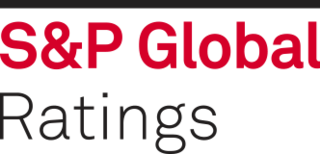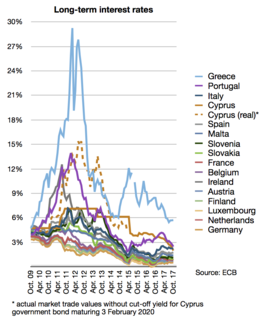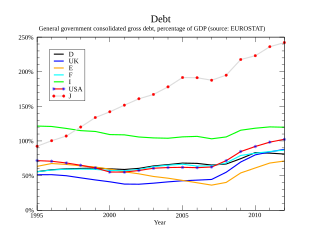
A government bond or sovereign bond is an instrument of indebtedness issued by a national government to support government spending. It generally includes a commitment to pay periodic interest, called coupon payments, and to repay the face value on the maturity date. For example, a bondholder invests $20,000 into a 10-year government bond with a 10% annual coupon; the government would pay the bondholder 10% of the $20,000 each year. At the maturity date the government would give back the original $20,000.

S&P Global Ratings is an American credit rating agency (CRA) and a division of S&P Global that publishes financial research and analysis on stocks, bonds, and commodities. S&P is considered the largest of the Big Three credit-rating agencies, which also include Moody's Investors Service and Fitch Ratings. Its head office is located on 55 Water Street in Lower Manhattan, New York City.

A credit rating agency is a company that assigns credit ratings, which rate a debtor's ability to pay back debt by making timely principal and interest payments and the likelihood of default. An agency may rate the creditworthiness of issuers of debt obligations, of debt instruments, and in some cases, of the servicers of the underlying debt, but not of individual consumers.
A credit rating is an evaluation of the credit risk of a prospective debtor, predicting their ability to pay back the debt, and an implicit forecast of the likelihood of the debtor defaulting. The credit rating represents an evaluation of a credit rating agency of the qualitative and quantitative information for the prospective debtor, including information provided by the prospective debtor and other non-public information obtained by the credit rating agency's analysts.

A collateralized debt obligation (CDO) is a type of structured asset-backed security (ABS). Originally developed as instruments for the corporate debt markets, after 2002 CDOs became vehicles for refinancing mortgage-backed securities (MBS). Like other private label securities backed by assets, a CDO can be thought of as a promise to pay investors in a prescribed sequence, based on the cash flow the CDO collects from the pool of bonds or other assets it owns. Distinctively, CDO credit risk is typically assessed based on a probability of default (PD) derived from ratings on those bonds or assets.

Sukuk is the Arabic name for financial certificates, also commonly referred to as "sharia compliant" bonds. Sukuk are defined by the AAOIFI as "securities of equal denomination representing individual ownership interests in a portfolio of eligible existing or future assets." The Fiqh academy of the OIC legitimized the use of sukuk in February 1988.
Moody's Investors Service, often referred to as Moody's, is the bond credit rating business of Moody's Corporation, representing the company's traditional line of business and its historical name. Moody's Investors Service provides international financial research on bonds issued by commercial and government entities. Moody's, along with Standard & Poor's and Fitch Group, is considered one of the Big Three credit rating agencies. It is also included in the Fortune 500 list of 2021.
In investment, the bond credit rating represents the credit worthiness of corporate or government bonds. It is not the same as an individual's credit score. The ratings are published by credit rating agencies and used by investment professionals to assess the likelihood the debt will be repaid.
Credit rating agencies (CRAs)—firms which rate debt instruments/securities according to the debtor's ability to pay lenders back—played a significant role at various stages in the American subprime mortgage crisis of 2007–2008 that led to the great recession of 2008–2009. The new, complex securities of "structured finance" used to finance subprime mortgages could not have been sold without ratings by the "Big Three" rating agencies—Moody's Investors Service, Standard & Poor's, and Fitch Ratings. A large section of the debt securities market—many money markets and pension funds—were restricted in their bylaws to holding only the safest securities—i.e. securities the rating agencies designated "triple-A". The pools of debt the agencies gave their highest ratings to included over three trillion dollars of loans to homebuyers with bad credit and undocumented incomes through 2007. Hundreds of billions of dollars' worth of these triple-A securities were downgraded to "junk" status by 2010, and the writedowns and losses came to over half a trillion dollars. This led "to the collapse or disappearance" in 2008–09 of three major investment banks, and the federal governments buying of $700 billion of bad debt from distressed financial institutions.

The European debt crisis, often also referred to as the eurozone crisis or the European sovereign debt crisis, is a multi-year debt crisis that has been taking place in the European Union (EU) since the end of 2009. Several eurozone member states were unable to repay or refinance their government debt or to bail out over-indebted banks under their national supervision without the assistance of third parties like other eurozone countries, the European Central Bank (ECB), or the International Monetary Fund (IMF).

From late 2009, fears of a sovereign debt crisis in some European states developed, with the situation becoming particularly tense in early 2010. Greece was most acutely affected, but fellow Eurozone members Cyprus, Ireland, Italy, Portugal, and Spain were also significantly affected. In the EU, especially in countries where sovereign debt has increased sharply due to bank bailouts, a crisis of confidence has emerged with the widening of bond yield spreads and risk insurance on credit default swaps between these countries and other EU members, most importantly Germany.
The United States debt-ceiling crisis of 2011 was a stage in the ongoing political debate in the United States Congress about the appropriate level of government spending and its effect on the national debt and deficit. The debate centered on the raising of the debt ceiling, which is normally raised without debate. The crisis led to the passage of the Budget Control Act of 2011.
The August 2011 stock markets fall was the sharp drop in stock prices in August 2011 in stock exchanges across the United States, Middle East, Europe and Asia. This was due to fears of contagion of the European sovereign debt crisis to Spain and Italy, as well as concerns over France's current AAA rating, concerns over the slow economic growth of the United States and its credit rating being downgraded. Severe volatility of stock market indexes continued for the rest of the year.
Several credit rating agencies around the world have downgraded their credit ratings of the U.S. federal government, including Standard & Poor's (S&P) which reduced the country's rating from AAA (outstanding) to AA+ (excellent) on August 5, 2011.
John B. Chambers is deputy head of the Sovereign Debt Ratings Group and chairman of the Sovereign Debt Committee at Standard and Poor's (S&P). Along with David T. Beers, Chambers earned significant attention in August 2011 for his role in downgrading the credit rating of United States Treasury bonds to AA+. Prior to this, the United States had maintained a AAA credit rating since 1941.
In finance and investing, Black Monday 2011 refers to August 8, 2011, when US and global stock markets crashed following the Friday night credit rating downgrade by Standard and Poor's of the United States sovereign debt from AAA, or "risk free", to AA+. It was the first time in history the United States was downgraded. Moody's issued a report during morning trading which said their AAA rating of U.S. credit was in jeopardy, this after issuing a negative outlook in the previous week.

Debt crisis is a situation in which a government loses the ability of paying back its governmental debt. When the expenditures of a government are more than its tax revenues for a prolonged period, the government may enter into a debt crisis. Various forms of governments finance their expenditures primarily by raising money through taxation. When tax revenues are insufficient, the government can make up the difference by issuing debt.

The Eurozone crisis is an ongoing financial crisis that has made it difficult or impossible for some countries in the euro area to repay or re-finance their government debt without the assistance of third parties.
The Greek government-debt crisis began in 2009 and, as of November 2017, was still ongoing. During this period, many changes had occurred in Greece. The income of many Greeks has declined, levels of unemployment have increased, elections and resignations of politicians have altered the country's political landscape radically, the Greek parliament has passed many austerity bills, and protests have become common sights throughout the country.

The Venezuelan economic crisis is the deterioration that began to be noticed in the main macroeconomic indicators from the year 2012, and whose consequences continue, not only economically but also politically and socially. The April 2019 International Monetary Fund (IMF) World Economic Outlook described Venezuela as being in a "wartime economy". For the fifth consecutive year, Bloomberg rated Venezuela first on its misery index in 2019.








